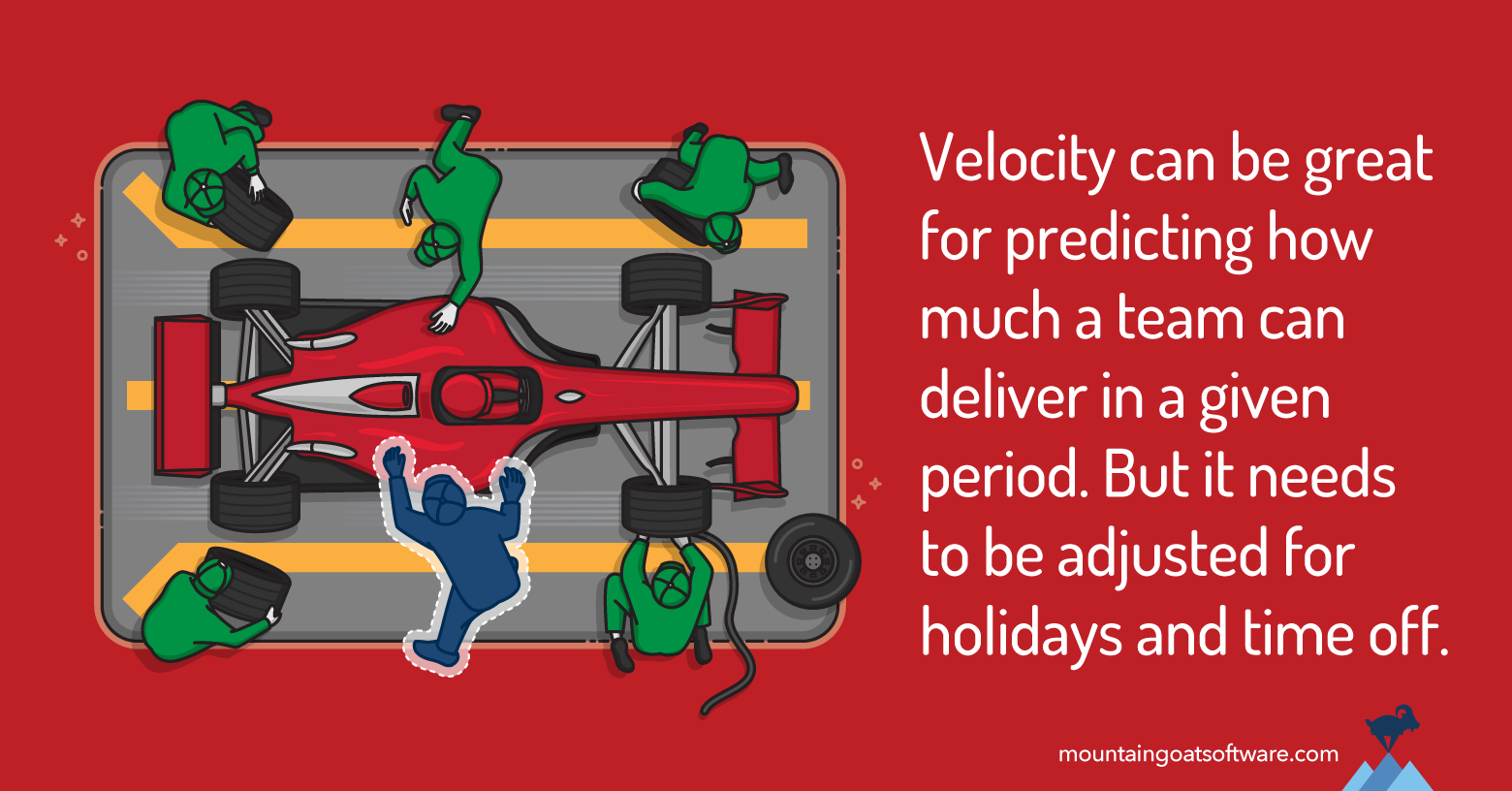Velocity can be a very useful predictor of how much work an agile team will complete in the future. It is beneficial for longer-term agile planning (looking forward at least four or five iterations).
Velocity is not as helpful for short-term planning because it can vary from iteration to iteration (which is why I recommend capacity-driven sprint planning over velocity-driven sprint planning).
Over the long-term as the law of large numbers kicks in and errors in individual product backlog items are balanced out, velocity can be a reliable predictor. Tracking velocity over time allows teams to make estimates like, “In the next 5 sprints we’ll probably finish between 100 and 120 story points.”
Such statements are based on a team knowing its velocity (perhaps as a single, averaged value but even better as a range).
How to Account for Time Off & Holidays in Long-Term Plans
But how should a team estimate its future velocity when team members are taking time off, whether personally or because of a company holiday?
There are a couple of different approaches to this. And each is appropriate in different contexts.
Approach 1: Ignore "Typical" Time Off
When adjusting estimated velocity for holidays, vacation or personal time, a simple but valid strategy may apply: Ignore it.
Ignoring the impact of various forms of time off can be a valid approach when planning over a sufficiently long period. The idea is that team members will probably take time off in the future at the same rate they took time off in the past.
If that seems true for the period for which you are planning, you don’t need to make any adjustments to velocity at all.
As a trivial example, suppose you are planning a project for all of next year. (I don’t recommend you commit to a fixed date and scope that far out, but it makes a good example.)
In this case, a good starting point will be the average velocity for all of this year. Any times of reduced productivity (such as Christmas or summer vacation time) will balance out over a long term.
Approach 2: Adjust Proportionately to the Full Team
In some cases, however, you do want to adjust for holidays and team member vacations. You should do this if you’re in a situation such as:
- The project is shorter (perhaps 3-6 months) and you don’t think time off during that period will be consistent with the past.
- You know that one or more team members will be out for a longer than normal period such as a sabbatical, birth of a new child, or just an extended vacation.
- One or more holidays with greater than normal impact occur during the period.
The simplest approach to making proportional adjustments is to assume that that everyone on a team can do everything. This is probably not true but it can be a starting point in deciding how to adjust velocity.
When making this assumption, the formula for predicted velocity in a sprint is:
Predicted Velocity = Average Velocity × (Planned Working Days ÷ Average Working Days)
To see how this formula would work, let's work with a hypothetical six-person team working in two-week sprints.
If everyone on that team worked a full day for every day of the sprint, they'd each work 10 days, or 60 days total (6 people X 10 days). It's highly unlikely that any team has members that work every day, every sprint with no time off or sick leave, though, so the average is typically less than than the maximum possible number of days.
Let's assume this team averages 55 working days per sprint for the past quarter, and that they have an average velocity of 40 points per sprint.
In the coming iteration, one team member will be out the full two weeks, and the rest of the team will be gone for one day for a national holiday. In the coming iteration they will lose 15 days to time off. (One person for ten days; the other five for a day each.) This leaves them 45 planned working days in the coming iteration.
To determine their predicted velocity for the upcoming sprint, take their historical average velocity (40) and multiply it by the percentage of days planned to be worked (45÷55=0.818 or 82%).
Predicted Velocity = 40 × (45÷55) = 32.72
This means their predicted velocity will be 32-33.
Approach 3: Adjust Proportionately Based on Skill
When team members are not highly interchangeable, a better approach can be to reduce velocity by the same percentage that a person’s absence represents within their primary skill.
For example, if one of two database administrators on a team will be gone for the entire sprint and no one else can do that work, reduce velocity by 50% since total DBA capacity is down that much.
For most roles this will be too dramatic of a reduction. The best approach I’ve found is to use somewhere between this amount and the amount given by assuming everyone is equal.
Let’s return to the case of one of two DBAs being gone for an entire iteration. And let’s assume the team is made up of six individuals running two-week (ten-day) iterations.
In this case, one DBA being gone represents a 50% reduction if the amount of work the DBAs will finish (1÷2). It also represents 17% less total capacity in the sprint (1÷6).
So, one DBA being out will likely reduce velocity between 17% and 50%. Choose a specific amount for your project based on whether DBA work is on or near the critical path and how interchangeable others are at helping with the DBA’s work.
What to Do When Multiple People Will Be Absent
If multiple people representing different skills will be absent during a coming sprint, reduce velocity only by the absence with the largest impact.
Think about it with this extreme example: Suppose 90% of your programming capacity will be gone if the coming sprint. And suppose 10% of your testing capacity will also be gone. The fact that you have slightly lower testing capacity won’t matter in the sprint. The total work done in this case will be determined by the much larger reduction in programming capacity.
As an example, let’s assume we have an 8-person team with two DBAs and three full-stack developers. Of these, one DBA and one developer will be absent for the entire sprint.
In this case, the DBAs will lose 50% of their normal capacity (1÷2) and the developers will lose 33% of theirs (1÷3). Treat those as upper limits on likely loss and then reduce velocity only by the larger of the two.
Choose the Approach that Works for Your Team
No matter which approach you choose, the key is to be consistent and transparent. The goal isn’t to predict velocity with absolute precision, but to create a shared understanding of how time off impacts your team’s ability to deliver. Choose the method that fits your context—and adjust as needed.
Last update: June 23rd, 2025









